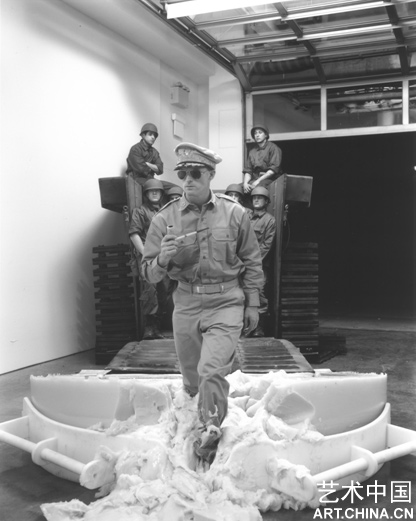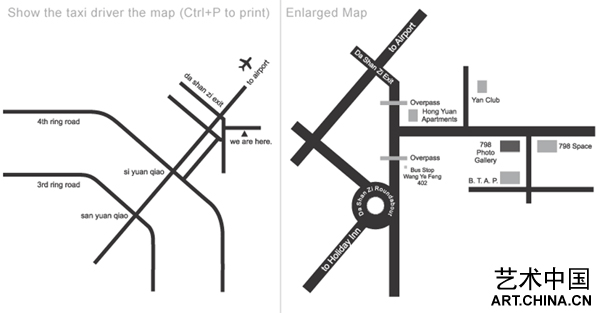| 百年印象攝影畫廊最新展覽
798 PHOTO GALLERY
“影像動(dòng)力學(xué)”藝術(shù)展
策展人:王春辰
參展藝術(shù)家:馬修?巴尼(Matthew Barney)、托馬斯?羅斯(Thomas Rose)、喬爾?菲爾德曼(Joel Feldman)、阿倫?沃爾克 + 拉茲?巴菲爾德(Allan Walker + Raz Barfield)、王川、劉瑾

馬修?巴尼:《繪畫拘束13》,2006年(Matthew Barney: Drawing Restraint 13, 2006)
開幕時(shí)間:2008年8月30日下午三點(diǎn)
展期:2008年8月30日至2008年9月26日
電話:010-64381784/64375284
電郵: 798@798photogallery.cn
網(wǎng)址:www.798photogallery.cn
地址:北京朝陽區(qū)酒仙橋路4號(hào)798工廠內(nèi)大山子藝術(shù)區(qū)百年印象攝影畫廊
Curator:Wang Chunchen
Artists: Matthew Barney、Thomas Rose、Joel Feldman、Allan Walker + Raz Barfield, Wang Chuan, Liu Jin
Opening time: Aug 30 - 3:00 pm, 2008
Exhibition time: Aug 30, 2008 - Sept 26,2008
Tel: 8610-64381784/64375284
E-mail:798@798photogallery.cn
Web:www.798photogallery.cn
Add: No.4, Jiu Xian Qiao Road, Chao Yang District, Beijing.
DIRECTION: 798 PHOTO GALLERY

影像動(dòng)力學(xué)
文/王春辰
動(dòng)力學(xué)作為現(xiàn)代物理學(xué)的一個(gè)分支學(xué)科,研究事物的運(yùn)動(dòng)規(guī)律和結(jié)構(gòu)以及相互關(guān)系,也成為現(xiàn)代語言的一個(gè)隱喻用語,被廣泛地應(yīng)用于不同門類的研究中。當(dāng)我們用動(dòng)力學(xué)來指向影像時(shí),就賦予了影像一種內(nèi)在的價(jià)值和它在當(dāng)代藝術(shù)發(fā)展的地位與功能。
當(dāng)代影像藝術(shù)包含了攝影、數(shù)碼、視頻等,成為藝術(shù)家探索、觀察與研究世界的新的觀念手段,它展示了無限豐富的創(chuàng)造機(jī)會(huì)和可能性,幫助藝術(shù)家實(shí)現(xiàn)各種充滿智慧與想象力的藝術(shù)觀念。藝術(shù)發(fā)展到今天,其觀念已經(jīng)發(fā)生了重大變化,已經(jīng)超越了具象寫實(shí)、單純模仿世界的認(rèn)識(shí),藝術(shù)家開始更加自主、自決地創(chuàng)造圖像世界、改造圖像世界、重新認(rèn)識(shí)圖像世界。這時(shí)候的影像藝術(shù)極大地改變了傳統(tǒng)的藝術(shù)形態(tài)和欣賞視角,這樣的藝術(shù)不僅僅是觀看,同時(shí)也是閱讀,既是觀眾自我經(jīng)驗(yàn)的投射,更是對(duì)自我經(jīng)驗(yàn)的挑戰(zhàn)和對(duì)抗。它不僅要求我們有強(qiáng)烈的視覺敏感性,對(duì)新的圖像具有接受能力,也要對(duì)新的圖像具有闡釋能力,同時(shí)也是將自己從傳統(tǒng)藝術(shù)的審美期待、現(xiàn)代主義的形式革命跨越到后現(xiàn)代主義的藝術(shù)多元與多樣并舉之中,成為一個(gè)具有多種圖像理解能力的讀者。圖像動(dòng)力學(xué)即是構(gòu)建這樣一種圖像閱讀新能力的視覺文化研究訴求。
本次展覽中的七位藝術(shù)家從不同方面例證了當(dāng)代的圖像動(dòng)力學(xué)的內(nèi)在機(jī)制和闡釋視角。它或是綜合的圖像創(chuàng)造,如馬修?巴尼稱之為“總體藝術(shù)”,將多種視覺方式加以綜合應(yīng)用,實(shí)現(xiàn)了當(dāng)代藝術(shù)的綜合性運(yùn)用,涉及到繪畫、雕塑、攝影、行為、電影與裝置。沃爾克與巴菲爾德利用各種圖像素材,通過計(jì)算機(jī)程序進(jìn)行合成,創(chuàng)造了流動(dòng)的超現(xiàn)實(shí)圖像世界。或是深入到影像背后的歷史與空間關(guān)系,如羅斯以建筑的藍(lán)圖為基礎(chǔ),重新思考了建筑空間與現(xiàn)實(shí)空間的聯(lián)合。菲爾德曼則是切入日常視覺經(jīng)驗(yàn)中,將社會(huì)景觀與社會(huì)意義進(jìn)行互證和對(duì)比,從而揭示了圖像閱讀的主觀性。王川是對(duì)圖像進(jìn)行解構(gòu),研究數(shù)字化時(shí)代的圖像本質(zhì)與圖像的生成機(jī)制,以期打開圖像創(chuàng)造的新方法。劉瑾作為觀念藝術(shù)家,始終強(qiáng)調(diào)圖像的觀念呈現(xiàn),將圖像的視覺化與行為表現(xiàn)的藝術(shù)觀念結(jié)合起來,突出了觀念介入圖像的主動(dòng)性。
這些藝術(shù)家在內(nèi)涵上各具特色、充分展示了影像表達(dá)的多種能力和方法論取向,體現(xiàn)了圖像在當(dāng)代社會(huì)語境中的創(chuàng)造能力和表意能力。因此,我們提倡“影像動(dòng)力學(xué)”就是希望深入探索當(dāng)代影像藝術(shù)的潛在創(chuàng)造能力和新的視覺理論問題。
(中央美術(shù)學(xué)院教師、美術(shù)批評(píng)家)
Image Dynamics
By Wang Chunchen
The science of dynamics, one of the branches of modern physics, studies the relationship between motion and the structure of matter. The term dynamics has also become a frequent metaphor applied to a wide range of subjects and fields of research. When we use this term to refer to images, we endow it with a kind of immanent value, giving it status and function within the development of contemporary art.
Contemporary photographic images produced within the scope of still-photography, digital works, or video function today as a conceptual means of exploring, observing and knowing the world. They open unlimited sources of creative possibilities and allow artists to realize their imaginative and often profound conceptions. Art, as it functions today, has changed dramatically. It has moved conceptually beyond figurative realism and simple mimetic representation of the world. As a result artists are becoming freer and more subjective in creating, changing and constructing their own images of reality. Photographic art has also undergone great changes, transforming how art in general is made and appreciated today. The new art is not simply for looking, but also for reading. It reflects the audience’s own experiences as well as challenges those experiences and creates confrontations. It requires us, as viewers, to have a flexible visual sensibility, to be able to accept new types of images, as well as shifts away from conventional aesthetic expectations and modernist forms towards postmodernist pluralism and heterogeneity. We must become readers to apprehend this diversifying image field. Image dynamics is a visual cultural study of how such new skills for reading photographic image are built.
The seven artists included in this exhibition exemplify the strategies and interpretative perspectives present in contemporary image dynamics. Their approach may refer to a comprehensive creation, such as the gesamtkunswerk art of Matthew Barney, who integrates various visual forms of contemporary art, including drawing, sculpture, photography, performance, film and installation. Allan Walker and Raz Barfield make use of computer programs to integrate various image elements in order to create a flowing, surreal image-world. Thomas Rose penetrates into the relationship between history and space by creating works based on architectural blueprints and rethinking the association of architectural space with real space. Joel Feldman verifies and contrasts social spectacles with social significance by interfering with daily visual experience, thus revealing the subjective dimension of image reading. Wang Chuan deconstructs images, looking for new methods of creating images, by studying the essence and the mechanism of image production and function in the age of digitalization. Liu Jin, a conceptual performance artist, always stresses the conceptual presentation of an image, combining the visual aspect of an image with performance in order to highlight the concept’s intervention into an image.
These artists have distinctive connotative inclinations and they represent a broad spectrum of approaches and methodological orientations that embody the creative and signifying abilities of the photographic image in our contemporary social context. The Image Dynamics exhibition aims to encourage further explorations of the potentialities inherent in the photographic medium and of the theoretical issues raised by the contemporary photographic images.
(Art Critic and Curator of China Central Academy of Fine Arts, Beijing) |

